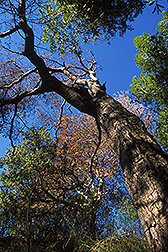This page has been archived and is being provided for reference purposes only. The page is no longer being updated, and therefore, links on the page may be invalid.
|
|
|
|
New Clues Discovered about Divergent Origin of Sudden Oak Death Pathogen
By Alfredo FloresMarch 27, 2009
Sudden oak death not only causes nearly instant death to the mighty oak trees of the western United States, but also has forced many tree nurseries out of business in that region. But a new Agricultural Research Service (ARS) discovery about the disease pathogen’s distant past--perhaps as long ago as half a million years--may offer clues to scientists about ways to thwart the disease.
A study led by ARS plant pathologist Nik Grunwald and collaborators at ARS and North Carolina State University has uncovered the ancient history of the killer Phytophthora ramorum fungus that causes the disease. This discovery could shed light on how the spread of P. ramorum began, according to Grunwald, at the ARS Horticultural Crops Research Laboratory in Corvallis, Ore.
Prior to this study, the relatedness of the three distinct clonal lineages, or genetic descendants, of P. ramorum--EU1, NA1 and NA2--was not known. The three lineages of P. ramorum are recent introductions to North America and Europe, and their origin is unknown.
But Grunwald and his team, after years of extensive analysis of DNA sequence data, found that the three lineages are between 1.5 million and 5.4 million years old and have been independently genetically mutating--altering their genes--for at least 11 percent of their history. From an evolutionary standpoint, this is a significant amount of time, estimated to be from 165,000 to 500,000 years.
Their evidence showed that the European lineage may be older than the North American lineages, and that the three lineages have originated from three different geographic locations rather than one location, prior to introduction to Europe and North America.
There now needs to be even greater caution when approving plant material for introduction into the United States that could introduce additional strains of the pathogen, according to the researchers.
These research results will be published in an upcoming edition of Molecular Ecology.
ARS is the principal intramural scientific research agency of the U.S. Department of Agriculture.

